
|
| Illustration: Laurel Mundy |
Entrepreneurs gear up to go green with personal transportation made from bamboo. Amy E. West rides into the hub. Illustrated by Laurel Mundy and Hypatia Saucer. |
 |
At the end of a dirt road in La Selva Beach, California, between airstrip-long fields and the Pacific Ocean, squats an unmarked warehouse full of green and brown tubes. Inside, a famed entrepreneur crafts triangles from these grass tubes by wrapping the joints with a mesh of bark fibers and translucent glue. This hollow structure then awaits its appendages: bits of rubber, aluminum, steel and carbon, affixed by flitting employees. Six weeks after the order is placed, a thrilled customer, lightened by $3,000, jumps on the road with this “functional work of art” and serenely pedals past cars stuck in traffic.
When it comes to commuting, biking is already the greener way to go. But a bicycle built from truly green components strikes many as the paragon of sustainable transportation—especially when that bike is made from bamboo.
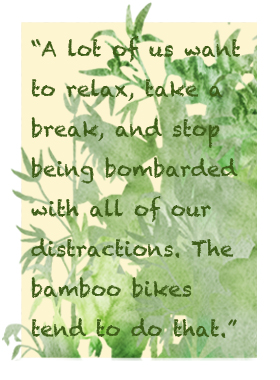 Powering this bamboo-manufacturing craze is Craig Calfee, owner of Calfee Design in the soul of California’s central coast. His handmade creations appeal to many riders, providing a truly organic connection to their bike. It also brings him and his fellow riders closer to simplicity. “A lot of us want to relax, take a break, and stop being bombarded with all of our distractions,” says Calfee. “The bamboo bikes tend to do that.” Powering this bamboo-manufacturing craze is Craig Calfee, owner of Calfee Design in the soul of California’s central coast. His handmade creations appeal to many riders, providing a truly organic connection to their bike. It also brings him and his fellow riders closer to simplicity. “A lot of us want to relax, take a break, and stop being bombarded with all of our distractions,” says Calfee. “The bamboo bikes tend to do that.”
Calfee’s creations started as a gimmick at a 1995 trade show. But their roots extend to 1894 when the Bamboo Cycle Company, Ltd first showcased then in England. The appeal and return to minimalistic design, such as simple single-speed bikes, also feeds the mania. And the trend is growing almost as fast as the bamboo shoots themselves.
Several companies have joined this green cycling wave, including Panda Bicycles and Boo Bicycles in Fort Collins, Colorado, and Bamboo Bike Studios in San Francisco and elsewhere around the country. At the Studio, euphoric students pedal away on their own hand-built bamboo bikes, awestruck by the smooth ride.
Calfee gained notoriety by bringing carbon fiber to the biking world. Top U.S. racer Greg LeMond and his team rode Calfee’s carbon-fiber bikes in the 1991 Tour de France. But his latest engineering twist in grassroots peddling may be his biggest challenge—and his most lasting cultural imprint. “Lots of stuff found in nature can replace a lot of the plastics and evil things we manufacture,” notes Calfee. “I am hoping I can inspire that thought with the bamboo bikes.”
Totally tubular
Calfee’s fascination with bamboo stems from its natural origins. “This tube is the perfect tube for a bicycle, and it grows out of the ground,” says Calfee, as down-to-earth as the bikes he crafts. “It is appealing to me on a deep level.”
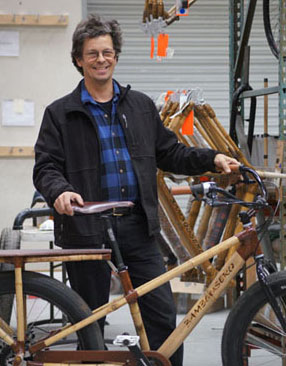 Photo: Amy West
Photo: Amy West |
Bicycle manufacturing entrepreneur Craig Calfee in his Calfee Design studios, La Selva Beach, California. (Click on photo to see larger version.) |
|
|
As an east coast kid, Calfee whizzed in and out of 500 acres of forests on his first “real” bike, a three-speed uncannily named “Tour de France.” After testing the limits of fallen trees by launching his bike off them, his appreciation for natural structures began to blossom. Such keepsakes adorn the windowsills in his meeting room: an impossibly perfect round stone, a woody cholla cactus skeleton, nautilus shells, and lava rocks.
On that shelf also sits a woody and curved palm-sized ladder. It looks like a fossilized vertebra, but it’s actually the bamboo root, or rhizome. From this, new shoots spring up in clumps or spread out in runners. The shoots, or culms, in some species grow three feet a day. Some stands reach a lofty 100 feet. Though they shoot up at their full diameter, the stalks are vulnerable until they mature and become woody in three years—requiring some serious sawing to cut them.
Bamboo’s ability to retain its tubular shape makes it strong for bikes. Unlike a tree’s woody rings, bamboo grows microscopic fibrous rings inward. They are densest and strongest at the culm’s outer edge. Fibers in some species have a higher tensile strength than certain alloys of steel.
More than a thousand species of this renewable resource exist. A stand of bamboo releases more oxygen than an equivalent stand of trees, and it absorbs comparable amounts of carbon, mostly in its root system. Not only that, says James Wolf, bamboo expert and builder for Boo Bicycles, bamboo draws heavy metals, toxins and animal waste from the earth. “It loves waste,” Wolf says with a smile.
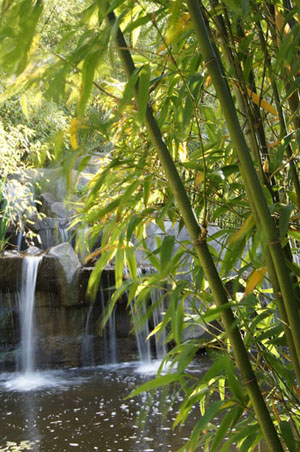 Photo: Amy West
Photo: Amy West |
|
|
Many bamboo species work for bikes. Wolf grows iron bamboo (Dendrocalamus strictus) on his own sustainable plantation adjacent to his bamboo home in Saigon, Vietnam. The bamboo used by the Bamboo Bike Studio (Phyllostachys spp.) or by Calfee is imported from Mexico, but theoretically could be grown locally. Establishing a grove and bringing bamboo to maturity from cuttings takes at least five years, says Calfee.
Commercial bamboo isn’t grown aggressively in the U.S., but some efforts have recently sprung up. Booshoot in Washington cultivates technology to grow bamboo on a commercial scale. Alabamboo endeavors to make Alabama its largest domestic source. With the help of an Alabama-based Bamboo Bike Studio, riders crafted bikes from their state-grown bamboo and rode across America to promote their mission. Calfee envisions his neighboring farm fields holding his personal stash of bamboo, one day.
Crafting cane
Just as Calfee ensured fine craftsmanship in carbon where others failed, he and Wolf also feel a responsibility to safeguard the reputation of bikes built from bamboo. According to Calfee, it took nearly 10 years for carbon fiber to gain acceptance in biking circles, with no Internet at the time to perpetuate the idea. By his calculation, he has about six years to go before bamboo reaches the same level of love. Riders are leery of a new material, he says, and a builder’s level of expertise can assuage or confirm their fears.
In a sense, bamboo is a natural composite, similar in many ways to carbon fiber’s makeup: thousands of threads of graphite and epoxy. A cross-section of bamboo reveals cellulose fibers as closely clustered microdots inside a silica-hardened exterior. Holding those fibers together is a sticky matrix called lignin. “It’s a binder, like eggs in cooking,” explains Justin Aguinaldo, who runs the Bamboo Bike Studio in San Francisco.
|
Amy West takes viewers on a ride into the growing industry of building bicycles made of bamboo. (Click on image to see video.) |
|
|
Bamboo’s natural composition gives it built-in shock absorbers. Energy transfers through its fibers, deadening road vibrations. Indeed, bamboo has four times the dampening power of carbon fiber, and it provides a smoother ride to boot, says Aguinaldo.
Bamboo scores major points for its strength and light weight. “You want a light bike, but you don’t want it to be a wet noodle,” Calfee explains. There is a fine balance to keep a bike stiff enough so pedaling energy isn’t wasted, stay light enough to lug around, yet tough enough to handle dings and crashes. Failure of some frame materials, like carbon fiber, can send riders to the hospital. But upon impact, bamboo returns to its natural shape. Even if it splits, it retains more than 95% of its strength, assures Wolf.
Since this woody grass tends to hold water, completely curing and sealing it is crucial so it won't swell during a hot and muggy Texas ride. Slowly drying bamboo in sunlight or with an open flame keeps it from splitting. Wolf puts his harvested bamboo to the test in an industrial desiccator, cycles moist Saigon air in and out, and then chooses pieces that survive split-free. After a worker assembles the frame, a coat of waterproof varnish seals it from the elements.
When Wolf receives a bicycle order, he approaches the build a little differently. He carefully selects the right pole to hold up to the weight of the rider. He then sets to the laborious task of hollowing out the solid bamboo to his calculated thickness. “It’s like doing a root canal for two feet,” he says, laughing.
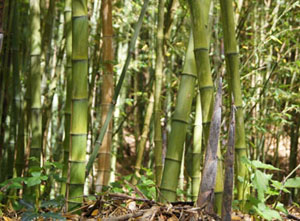 Photo: Amy West
Photo: Amy West |
|
|
The next step is permanently fusing the bamboo together, since the joints suffer the most sustained stress. Initially, Calfee used the hair-like fibers of carbon to marry the bamboo joints. But he found this to be an unhappy union. His attraction to natural fibers first led him to hemp, and eventually to a bark cloth native to Uganda. This renewable resource of woody bark, once pounded into a crisscrossing fibrous cloth, is an ideal replacement to carbon fiber. Calfee solidifies this coupling with a soy-based resin, replacing the usual toxic epoxy.
Molding with natural materials didn’t always work for Calfee, a classically trained sculptor. His “rack of shame” hangs as a visual hodgepodge of carbon and bamboo bike designs that weren’t successful for one reason or another. Some of those unrideable creations are from his Bamboosero project, a collaboration of bamboo bike makers in parts of Africa and New Zealand (see sidebar: Biking Out of Africa).
But sometimes his creative attempts do work. “I realized at a certain point that we could make a bicycle out of anything—even PVC [plastic],” says Calfee. One of his bikes with swoopy bamboo tubes substitutes animal horns for the handlebars and fork. He sees horns not as stylish, but as “one of the most refined structures around. Most horn materials are designed and evolved for fighting,” he reasons. “And the winner gets to reproduce.”
The green wheel ideal
The push to go greener with bikes means simply improving upon current manufacturing standards. Mass-produced bikes typically contain steel, aluminum, carbon, and small amounts of titanium. Most bicycle owners don’t understand how these raw materials metamorphose into bikes, Calfee says. Extracting and refining iron ore, bauxite, and igneous rock comes with environmental costs, usually suffered by other countries. The transportation may be sustainable, but it still involves some manufacturing emissions.
 Photo: Amy West
Photo: Amy West |
|
|
Most large bike companies manufacture their frames in Asia. Many components, such as chains, tires, and tubes, also are produced abroad. The reduced labor costs and lax environmental laws make it affordable for American bike companies.
“Mass production produces mass gains in efficiency,” notes Greg McPheeters, a solar design engineer and founder of Moved by Bikes. “Custom-made bikes are expensive, and most people can't afford them.”
But there already is a market for custom-built bikes, and a few of those companies operate with the environment in mind. John Caletti, the one-man operation behind Caletti Cycles of Santa Cruz, builds durable custom steel frames. He can’t offset his entire carbon footprint from building bikes, so he partnered with One Percent for the Planet, giving one percent of his revenue to environmental organizations. He ships by ground, and he plans to use less power in welding by installing solar arrays.
Caletti doesn’t see many examples of green building from the mass manufacturers. “I think the bikes that are the most affordable are the least durable,” he says. “What do the mass manufacturers do with their waste? Do they recycle?”
But to Caletti and other builders, the definition of green bike manufacturing is complicated. Evaluating the ecological costs of shipping, sourcing, growing, extracting, or manufacturing any material—especially one that’s recyclable or biodegradable—is tricky. Caletti places more value in creating a highly recyclable bike with a long lifespan.
As for bamboo, the public’s knee-jerk reaction is to doubt its durability. However, Calfee is still riding the first one he made in 1995—far surpassing his 10-year warranty. Boo Bicycles attaches a lifetime warranty to its models. Both Wolf and Calfee agree that the builder’s skill, knowledge and sealing of the bamboo are key to the bike’s longevity.
There may not be great public demand for greener bicycles, but there are many like Calfee who have a personal drive toward it. He acknowledges that in the grand scheme of environmental costs, bike manufacturing is minor. “If any industry ought to be given a break in terms of its carbon footprint, it should be bicycles,” he says. “The end product, in theory, is displacing a car.”
Caletti’s wife Cory, a transportation planner for the City of Santa Cruz, agrees. “In my world, we just want to get people on bikes,” she says. Every mile traveled by bike instead of a car saves a pound of greenhouse gas, she notes.
The amount of energy in making, say, a steel bike frame is a drop in the bucket when compared to the energy saved by riding it, says McPheeters. “When you look at the whole transportation system, the amount of energy and resources going into a bike frame of any material is a blip,” he says.
Growing proudly
Self-described as an obsessed bamboo builder, Justin Aguinaldo hasn’t owned a car for the last 12 years. He doesn’t like using green buzzwords for bamboo, but he does know what a comfortable bamboo bike has done for him: He rides more. “If you want to get people off couches, we should make their couches out of tubed steel,” he says.
The do-it-yourself ethos draws people to Aguinaldo's workshops. Here, anyone can learn how to build a bamboo bike in a weekend for about $700. Jun Sunseri, a Berkeley archaeology professor, did just that in 22 hours. Sunseri had previously worked with aluminum, steel, and carbon fiber as an engineer; the bamboo bike was the first custom bike he built. “I was so amazingly pleased, I can’t even tell you,” he says. Makers of mass-produced bikes often try to mimic bamboo’s smooth ride by sticking rubber grommets in the frame to dampen the road chatter, Sunseri explains.
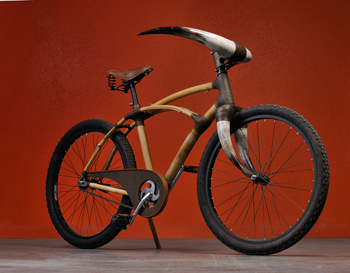 |
| Photo: Paul Schraub |
Craig Calfee's bamboo bike with animal horns.
(Click on photo to see larger version.) |
|
|
Jacob Castillo, co-founder of Panda Bicycles, knows why riders prefer bamboo: “They are butter smooth. There is this great visual when you look down. It’s something completely unique. And I am not gonna lie, they look awesome!” James Wolf puts it this way: “It’s like the road you are riding on becomes a better road.”
Bamboo also is more accessible to the general bike-building enthusiast. Without training, a workshop, or power tools, Santa Cruz engineer Alex Yasbek built a Swiss Family Robinson style cargo bike. He said building one from steel seemed intimidating. His motivator to use bamboo: “The ride is amazing.”
The popularity of bamboo bikes has soared in the last four years, catching the attention of a few professional cyclists. But manufacturing hurdles exist. The labor-intensive process and inconsistencies in cane size, shape, and thickness make it hard to mass-produce the bikes in aesthetically pleasing and economical ways, Calfee says. Wolf agrees: “Not all bamboos are equal. Even the same species growing on the same hill from the same plant will have very different properties if they are cut at different ages. That's a challenge when dealing with a natural material.”
What remains consistent is the fierce pride felt by bamboo bike builders about their creations. Their dedication to this organic bike material arises not only from an ideal in bike manufacturing, but also from the economics that seem to work in a niche market. Despite the many incentives to remain ensconced in a motorized world, the momentum toward the two-wheeled lifestyle is palpable. And fascination with a bike made from grass, which is both comfortable and visually striking, drives consumers toward this greener transportation trend.
As for Calfee, he continues to dream up more designs. “I would love a full-on Gilligan’s Island bike where there is no metal in it, and it’s all coming out of the forest,” he says.
With his bamboo bike fashioned with animal horns, he’s more than halfway there.
Sidebar: Biking Out of Africa
Craig Calfee has brought the art of bamboo bike building to developing countries, enabling communities to generate income from craftsmanship using their natural resources. The venture, called Bamboosero, sprang from something like this:
Give a man a bike, and he can travel for a day. Teach a man how to make a bike, and he creates jobs for his neighbors. Buy his bike, and his business grows and prospers.
Calfee started Bamboosero after traveling through Africa and noticing the wealth of bamboo and the dearth of bikes. When he thought about where labor was most needed, Africa stood out. “They have bamboo, craftspeople, athletes, and they use bicycles,” he says.
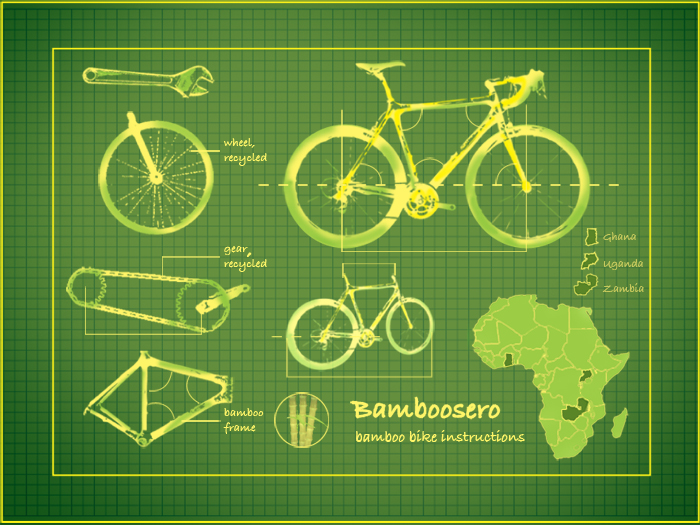 |
Illustration: Hypatia Saucer |
|
He formed partnerships with local entrepreneurs in Ghana, Uganda, and New Zealand in 2007 and 2008. He trained them to build quality and stress-tested bamboo bikes with their local bamboo and fibers. He ships the groups a few metal pieces for framing and the blueprints for how to construct the frames. The partners can sell their frames locally, but most are shipped back to Calfee. His team inspects them again, and then American riders scoop them up for about $800.
Bamboosero training has extended to artisans in New Zealand. Kiwis spray Maori art on the bamboo frames, and they wrap the joints with New Zealand flax fiber.
Calfee continues to find innovative ways to bring a bicycle industry to other nations. Organized African bike tours using Bamboosero bikes help finance the project, and tourists can even pay to ship their bikes home. “The locals are amazed that Americans are coming over and riding a locally-made product,” he says.
Though Africans desperately need robust bikes, Calfee can’t compete with the cost of the donated used bikes. Rather, Bamboosero bikes are available to locals on a rent-to-own basis. Buying from builders in developing countries makes bamboo frames more affordable and pumps foreign dollars into poor economies, Calfee says: “The supply is infinite because there are literally millions of people capable of making these beautiful frames.”
And in a high-profile endorsement, Angelina Jolie and Brad Pitt bought six of Calfee’s bamboo bikes as gifts for friends to support his efforts in Africa.
Story ©2012 by Amy E. West. For reproduction requests, contact the Science Communication Program office.
Top
Biographies
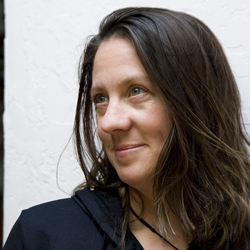 Amy E. West Amy E. West
B.S. (marine biology) University of the Virgin Islands
MSc (marine science) University of Otago, New Zealand
Internship: Golden Gate National Parks Conservancy, video production (San Francisco)
I did everything against the grain. I left a landlocked state to study the ocean, joined Peace Corps to live among cannibals, moved to New Zealand for graduate school without first being accepted, and racked up research experience worldwide in subjects ranging from sifters (phytoplankton) to drifters (whales) without climbing any career ladder. I was astonished I could thrive in any research environment, yet be overlooked professionally because of my diverse interests.
Obviously, I couldn’t play the role of conventional scientist. Nor did I want to.
Instead, I envisioned channeling Sylvia Earle, Jacques Cousteau, and Rachel Carson collectively to publicly demonstrate the relevance of marine science. Unsolicited written stories, videos, and even hand gestures had been my tools. I’ve now discovered a more formal approach to communicating science and a way to go with the grain.
. . . . . . . . . . . . . . . . . . . . . . . . . . . . . . . . . . . . . . . . . . . . . . . . . . .
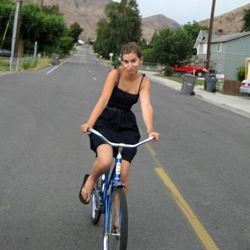 Laurel Mundy Laurel Mundy
B.S. (ecology, evolution, and organismal biology) Western Washington University
Internship: Seattle Audubon Society
I am a wildlife biologist, and now quite happily a scientific illustrator, born and raised in Seattle, Washington. My passion for drawing has only ever been second to my passion for the outdoors, both in a recreational and academic sense. I am constantly wanting to learn about, explore, and understand my surroundings.
My background is primarily in birds, and particularly owls. I got to know the spotted owl especially well after graduating from my undergraduate studies, when I had two seasons' worth of field survey jobs looking for the elusive birds. I would like to continue pursuing my owl calling (both literally and figuratively) as a secondary part to my new career as an illustrator. I hope to illustrate field guides, interpretive signs, and to aid in education and conservation of endangered species (the spotted owl included!) and environmental awareness. If you are interested in viewing more of my work, please visit my website.
. . . . . . . . . . . . . . . . . . . . . . . . . . . . . . . . . . . . . . . . . . . . . . . . . . .
 Hypatia Saucer Hypatia Saucer
B.A. (anthropology; pre-health concentration) University of Michigan
Internship: New York City restaurant group
I am an illustrator who loves to combine illustration and graphic design. I enjoy experimenting with color and finding unique compositions by drawing from interests in vintage advertisements, children’s books, architecture and fashion. I won’t hesitate to tell you that "It’s great to be a Michigan Wolverine," but as I've recently learned from CSU Monterey Bay, "There’s nothing hotter than an otter." After my illustration internship for a restaurant group in New York, I hope to foster a career in illustration and graphic design.
Top |

